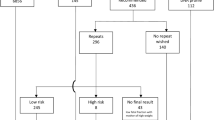Abstract
Objective
Cell free DNA (cfDNA) testing has evolved as an important tool in prenatal screening for trisomy 21. It can also be used in screening for monosomy X. We perform a systemic review to determine the detection and false positive in screening for monosomy X and demonstrate a case that offers two possible explanations for the lower screening performance compared to trisomy 21.
Case
A 31-year-old primigravida was referred to us due to an abnormal cfDNA test indicating monosomy X. However, the genitalia was male. An amniocentesis was done that indicated 46,X,idic(Y)(q11.21). SNP array analysis confirmed the Ypter-q11.21 duplication. A phenotypically normal male baby was born at 40 weeks. Postnatal karyotyping of several pregnancy tissues was carried out. While in most samples the karyotype was 46,X,idic(Y)(q11.21), in the four placenta samples and in the amniotic membranes there was mosaicism of 46,X,idic(Y)(q11.21) and 45,X.
Data sources
A search of the Medline and Embase database was done for articles about screening for monosomy X by cfDNA. We performed a systematic review to assess the detection and false-positive rate.
Results
Seven studies fulfilled the inclusion criteria. In summary, there were 153 pregnancies with monosomy X and 4116 euploid ones. The detection and false-positive rate was 94.1 and 0.53 %.
Conclusion
Although the performance of cfDNA in prenatal screening for monosomy X is better than any other screening test, it is not comparable with invasive testing. One should be aware of the limitations especially if the ultrasound examination is contradictory with the cfDNA results.


Similar content being viewed by others
References
Kagan KO, Wright D, Valencia C et al (2008) Screening for trisomies 21, 18 and 13 by maternal age, fetal nuchal translucency, fetal heart rate, free-hCG and pregnancy-associated plasma protein-A. Hum Reprod 23:1968–1975
Gil MM, Quezada MS, Revello R et al (2015) Analysis of cell-free DNA in maternal blood in screening for fetal aneuploidies: updated meta-analysis. Ultrasound Obstet Gynecol 45:249–266
Kagan KO, Eiben B, Kozlowski P (2014) Kombiniertes Ersttrimesterscreening und zellfreie fetale DNA—”Next Generation Screening”. Ultraschall Med 35:229–236
Schmid M, Klaritsch P, Arzt W et al (2015) Cell-Free DNA testing for fetal chromosomal anomalies in clinical practice: Austrian-German-Swiss recommendations for non-invasive prenatal tests (NIPT). Ultraschall Med 36:507–510
Bianchi DW, Parsa S, Bhatt S et al (2015) Fetal sex chromosome testing by maternal plasma DNA sequencing. Obstet Gynecol 125:375–382
Mennuti MT, Chandrasekaran S, Khalek N, Dugoff L (2015) Cell-free DNA screening and sex chromosome aneuploidies. Prenat Diagn 35:980–985
Srebniak MI, Diderich KEM, Noomen P et al (2014) Abnormal non-invasive prenatal test results concordant with karyotype of cytotrophoblast but not reflecting abnormal fetal karyotype. Ultrasound Obstet Gynecol 44:109–111
Gardner RJM, Sutherland GR, Shaffer LG (2012) Chromosome abnormalities and genetic counseling, 4th edn. Oxford Monographs on Medical Genetics No. 61
Tuck-Muller CM, Chen H, Martínez JE et al (1995) Isodicentric Y chromosome: cytogenetic, molecular and clinical studies and review of the literature. Hum Genet 96:119–129
Hsu LY (1994) Phenotype/karyotype correlations of Y chromosome aneuploidy with emphasis on structural aberrations in postnatally diagnosed cases. Am J Med Genet 53:108–140
Colmant C, Morin-Surroca M, Fuchs F et al (2013) Non-invasive prenatal testing for fetal sex determination: is ultrasound still relevant? Eur J Obstet Gynecol 171:197–204
Nicolaides KH, Musci TJ, Struble CA et al. (2014) Assessment of fetal sex chromosome aneuploidy using directed cell-free DNA analysis. Fetal Diagn Ther 35(1):1–6
Hooks J, Wolfberg AJ, Wang ET et al. (2014) Non-invasive risk assessment of fetal sex chromosome aneuploidy through directed analysis and incorporation of fetal fraction. Prenat Diagn 34(5):496–499
Salomon LJ, Alfirevic Z, Audibert F et al (2014) ISUOG consensus statement on the impact of non-invasive prenatal testing (NIPT) on prenatal ultrasound practice. Ultrasound Obstet Gynecol 44:122–123
Guex N, Iseli C, Syngelaki A et al. (2013) A robust second-generation genome-wide test for fetal aneuploidy based on shotgun sequencing cell-free DNA in maternal blood. Prenat Diagn 33(7):707–710
Mazloom AR, Džakula Z, Oeth P et al. (2013) Noninvasive prenatal detection of sex chromosomal aneuploidies by sequencing circulating cell-free DNA from maternal plasma. Prenat Diagn 33(6):591–597
Samango-Sprouse C, Banjevic M, Ryan A et al. (2013) SNP-based non-invasive prenatal testing detects sex chromosome aneuploidies with high accuracy. Prenat Diagn 33(7):643–649
Pergament E, Cuckle H, Zimmermann B et al. (2014) Single-nucleotide polymorphism-based noninvasive prenatal screening in a high-risk and low-risk cohort. Obstet Gynecol 124(2 pt 1):210–18
Bianchi DW, Platt LD, Goldberg JD et al (2012) Genome-wide fetal aneuploidy detection by maternal plasma DNA sequencing. Obstet Gynecol 119(5):890–901. doi:10.1097/AOG.0b013e31824fb482
Author information
Authors and Affiliations
Corresponding author
Ethics declarations
Funding
No funding.
Conflict of interest
Each author confirms that they do not have any conflict of interests.
Ethical approval
The study was registered by the local ethical committee. All procedures performed in studies involving human participants were in accordance with the ethical standards of the institutional and/or national research committee and with the 1964 Helsinki declaration and its later amendments or comparable ethical standards.
Rights and permissions
About this article
Cite this article
Kagan, K.O., Hoopmann, M., Singer, S. et al. Discordance between ultrasound and cell free DNA screening for monosomy X. Arch Gynecol Obstet 294, 219–224 (2016). https://doi.org/10.1007/s00404-016-4077-y
Received:
Accepted:
Published:
Issue Date:
DOI: https://doi.org/10.1007/s00404-016-4077-y




